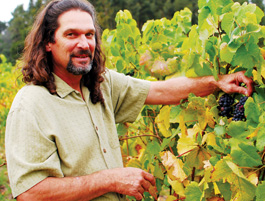home | metro santa cruz index | dining

Photograph by Brian Harker
BRIXABRAC: Richard Alfaro, pictured at harvest time in 2009. This year, he says, his pinot grapes are showing 'low sugars with great physiological ripeness.'
The Crush Is On!
And by all accounts, the unlikely 2010 growing season could make for a great vintage
By Christina Waters
RYAN BEAUREGARD is keeping his eyes on two ripening situations right now. One of them involves many tons of premium wine grapes.
The other one is the any-minute-now birth of his next child. "Having a baby in the middle of harvest," he gasps. "I hope this is a one-time event!"
If he's understandably more anxious right now than most of his colleagues, he is very bullish on the vintage of 2010.
"It's a great harvest," he admits. "The cold growing season gave us ripe fruit at lower Brix." That's winespeak for the possibility of making voluptuously rich wines with relatively low alcohol. Most years, Beauregard notes, he and other Santa Cruz Mountain winemakers harvest at 25 Brix (Brix being a sugar measurement). "This year, we are pulling fruit in at 22.5 to 23.5 with a pH of 3.56. The numbers are textbook perfect this year."
Others I spoke with agree that 2010 is looking very, very promising, despite the cool summer and recent temperature spikes.
"It was the most unusual growing year I've seen," agrees Jim Schultze, winemaker at Windy Oaks Estate at the southern end of the region, "with flavors developing earlier than ever. We're harvesting right now and the numbers are ideal—perfect pH." (Winemakers adore science-speak.) "The aromas are some of the best I've encountered, and it could just turn out that this strange year will be one of the best ever. You never know with farming."
Richard Alfaro chimes in from the midst of his multivineyard pinot noir harvest.
"The fruit is late but wonderful," he says. Like many other Santa Cruz appellation winemakers, Alfaro is seeing "low sugars with great physiological ripeness."
Rachel Ormes, Vine Hill Winery viticulturist, explains that La Niņa created the cool wet spring and summer that kept the vines moist into June and July. "But pinot likes the cooler temperatures," she adds. "So the yields might be lower, but the fruit is very well developed and full of lots of nice flavors."
Bradley Brown at Big Basin Vineyards admits that he's been "pretty much jumping up and down" over the quality of this year's grapes. He also helped explain the consequences of the weird growing season.
"The heat we're having now is helping the vines to catch up, but the cooler weather in the summer helped the sugars stay put, even while the phenolics kept developing," he says. (Phenolics are the elements of the grapes' biochemistry that develop gorgeous color, ripe tannins and ultimate complexity.) "If the Brix are too high, it cooks all the complexity out," he explains. "Because the brix are so low now, we have a potential for long 'hang time.'"
And that means long-lived wines. We'll know in about two years. Two long, anticipation-filled years.
Send letters to the editor here.
|
|
|
|
|
|